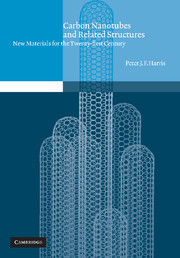Book contents
- Frontmatter
- Contents
- Acknowledgements
- 1 Introduction
- 2 Synthesis: Preparation methods, growth mechanisms and processing techniques
- 3 Structure
- 4 The physics of nanotubes
- 5 Nanocapsules and nanotest-tubes
- 6 The ultimate carbon fibre? The mechanical properties of carbon nanotubes
- 7 Curved crystals, inorganic fullerenes and nanorods
- 8 Carbon onions and spheroidal carbon
- 9 Future directions
- Name index
- Subject index
5 - Nanocapsules and nanotest-tubes
Published online by Cambridge University Press: 28 January 2010
- Frontmatter
- Contents
- Acknowledgements
- 1 Introduction
- 2 Synthesis: Preparation methods, growth mechanisms and processing techniques
- 3 Structure
- 4 The physics of nanotubes
- 5 Nanocapsules and nanotest-tubes
- 6 The ultimate carbon fibre? The mechanical properties of carbon nanotubes
- 7 Curved crystals, inorganic fullerenes and nanorods
- 8 Carbon onions and spheroidal carbon
- 9 Future directions
- Name index
- Subject index
Summary
Daedalus … is now seeking ways of incorporating ‘windows’ into their structure so that they can absorb or exchange internal molecules …
David Jones, New Scientist, 3November, 1966When Daedalus dreamed up hollow graphitic molecules in the mid-sixties he speculated that they would make ideal molecular containers, and so it has proved. The first demonstration of this came just a few days after the discovery of C60 in September 1985 when Kroto, Smalley and their colleagues prepared the first metallofullerene, La@C60 (5.1). This not only provided further, perhaps definitive, proof that the cage hypothesis was correct, but also marked the beginning of a whole new field of molecular science. Subsequent work has shown that many different atoms ranging from rare gases to uranium can be encapsulated inside fullerenes (5.2, 5.3), although testing the properties of these materials has been difficult, since they can currently only be produced in small amounts. There is also interest in the idea of chemically creating openings in fullerenes, to allow foreign molecules in and out (5.4), in exactly the way envisaged by Daedalus.
When carbon nanotubes and nanoparticles arrived it was natural that attempts would be made to introduce foreign materials into the central cavities. Two approaches were tried, and both proved successful. The first involved carrying out arc-evaporation in the usual way, but with an anode containing some of the material to be encapsulated. This technique generally seems to favour the formation of filled nanoparticles rather than nanotubes, and is only applicable to materials which can survive the extreme conditions of the electric arc.
Information
- Type
- Chapter
- Information
- Carbon Nanotubes and Related StructuresNew Materials for the Twenty-first Century, pp. 156 - 185Publisher: Cambridge University PressPrint publication year: 1999
